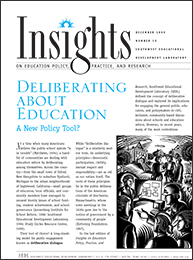References & Credits
References
- Annenberg Institute for School Reform. (1998). Reasons for hope, voices for change. A report of the Annenberg Institute on Public Engagement for Public Education. Providence, RI: Author.
- Bohm, D. (1989, November). On dialogue. Seminar conducted in Ojai, CA.
- Guzman, J. (1999). Speak up! Engaging policymakers with educators and communities in deliberative dialogue. Insights on Education Policy, Practice, and Research, 9. Austin, TX: Southwest Educational Development Laboratory.
- Kettering Foundation. (1997). Making choices together: The power of public deliberation. Dayton, OH: Author.
- Kettering Foundation. (n.d.). For convenors and moderators: Organizing for public deliberation and moderating a forum/study circle. Dayton, OH: Author.
- Matthews, D. (1996). Is there a public for public schools? Dayton, OH: Kettering Foundation Press.
- Mutchler, S. (1993). Education activism of cultural conservatives. Insights on Education Policy and Practice, 3. Austin, TX: Southwest Educational Development Laboratory.
- Mutchler, S. E., & Knox, L. (1998). Changing the state political context for education through local deliberative dialogue. Paper presented at the annual meeting of the American Educational Research Association, San Diego, CA.
- National Conference of State Legislatures. (1997). Too much democracy. State Legislatures, 23(10), 14-21.
Pan, D. (1999). [Breakdown of information sources legislators report using in state policy decision making]. Unpublished raw data. - Schein, E. H. (1993). On dialogue, culture, and organizational learning. Organizational Dynamics 22,(2), 40-51.
- Senge, P. M. (1994). The fifth discipline fieldbook: Strategies for building a learning organization. New York, NY: Doubleday.
- Southwest Educational Development Laboratory. (1996, October). Deliberative dialogue: Engaging the public in education policy. Proceedings of the Regional Policy Analysts Networkshop, Austin, Texas.
- Study Circles Resource Center. (1999). Focus on study circles, 10(2). Pomfret, CT: Topsfield Foundation.
- Study Circles Resource Center. (1996). Planning community-wide study circle programs: A step-by-step guide. Pomfret, CT: Topsfield Foundation.
- Weaver, S. W. & Geske, T. G. (1997). Educational policy making in the state legislature: Legislator as policy expert. Educational Policy, 11(3), 309-329.
- Yankelovich, D. (1992, October 5). How public opinion really works. Fortune, 102-104, 108.
Credits
This issue of Insights was written by Kyle Johnson, freelance writer, and Sue Mutchler, SEDL Program Associate, and edited by Joyce Pollard, Director of Institutional Communications and Policy Services. We gratefully acknowledge Dr. Lyndee Knox, Director of Research & Evaluation, USC Department of Family Medicine, and Diane Pan, SEDL Program Specialist, for significant contributions to the research base for this publication.
Insights on Education Policy, Practice, and Research may be reproduced and copies
distributed to members by educational agencies, organizations, and associations.
This publication is based on work sponsored wholly, or in part, by the Office of Educational Research and Improvement, U.S. Department of Education, under Contract #RJ96006801. The contents of this publication do not necessarily reflect the views of OERI, the Department, or any other agency of the U.S. Government.

